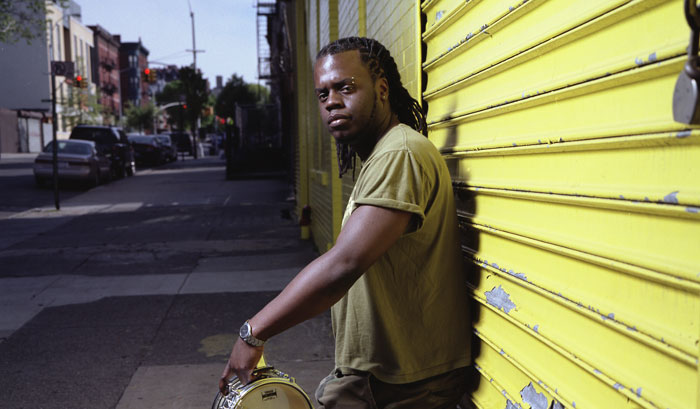


Drummer Greg Hutchinson rose to fame in the '90s as part of a new generation of jazz musicians with old-school sensibilities. Like his sometime collaborators, trumpeter Roy Hargrove and saxophonist Joshua Redman, Hutchinson blended youthful fire with a well-informed perspective on classic jazz.
Since then, the Brooklyn-based musician has kept one eye on the past and one on the present. In the last year alone, Hutchinson has worked with Redman, vocalists Diane Reeves and Harry Connick, Jr., and rapper Common. "I have my hand in all the grab bags," he chuckles. "But whatever style of music you play, you have to want to play it authentically. If you can't do that, then don't play it!"
Groove is the essence of music. If you can hit a groove in any style, you'll always have work.
Hutchinson counts himself lucky to have worked with some of the greats of previous generations before they passed on--notably trumpeter Red Rodney, bassist Roy Brown, saxophonist Joe Henderson, and vocalist Betty Carter. "When you get to work with people who were actually around when jazz was created, you get a whole different sense of what the music is about," he reflects. "Those musicians took their craft very seriously. It was their lives. The things you learn from them apply to everything: How to conduct business. How to play on the road. Understanding what it takes to be successful and attain longevity in the business."

Despite his jazz pedigree, Hutchinson is also perfectly at home playing hip-hop, pop, and R&B. "I just like good music," he shrugs. "I gravitated toward jazz because my mom used to play all those great Sonny Rollins and Art Blakey albums around the house. But my dad came from Trinidad, so I also grew up with all kinds of groove music from the islands. Groove is the essence of music. If you can hit a groove in any style, you'll always have work."
Unlike some jazz players, Hutchinson says he enjoys playing to a click when the style demands it: "A lot of drummers get confused about playing with a click, but it's really simple. Think about it: You have something else keeping a steady pulse for you--how can you go wrong? If you can just listen and play two and four, you'll do fine. Eventually you'll learn how to play over the click, or behind it, or place just the bass drum or snare drum behind. The way I see it, the click is your friend!"
Hutchinson often compares drumming to singing. "You can't just pound the drums," he insists. "You have to know the song's melodies. You have to know where you are in the structure. Instead of just beating on the drums, it helps if you caress the sound out of them. A lot of my students come in thinking this means hitting harder. But it's really about understanding the connection between the stick and the drum. You need a quick release from the head. If the drumstick stays next to the head, the drum is muffled. When you apply full pressure to the bass drum, you get a thud. But when you release the pedal quickly so the beater barely hits the head, you can actually control the pitch of the bass drum."
Hutchinson is a longtime Yamaha user. "I play a custom kit that combines some features from the Absolute series with some from the Maple Customs," he says. "Yamaha and I did something very unusual with my snare: It's piccolo-sized, but it's 14-ply thick. It's got more body than a conventional piccolo. You can tune it as high as you want, and it just keeps going higher without giving up the bottom. That thing cracks!"
"I'm loving my Yamaha drums," says Greg. "They're dependable, and the Yamaha guys are always cool. They care about longevity and building relationships. I have nothing but raves for the company."
Greg usually opts for a five-piece kit with 12"x9", 13"x10", and 13"x13" toms. "I gravitate back in forth in terms of their tuning," he says. "Some days I want to be Philly Joe Jones. Some days it's Jimmy Cobb. Some days it's Dennis Chambers. I don't like to change the tuning so much that I stop being me, but you do have to adjust them according to the style. A high jazz tuning doesn't work in every setting. You can't do an R&B gig and play a drum fill that sounds like roto-toms. I've also been practicing at home with a big old 24" bass drum." He laughs. "Hey, every drummer wants to be John Bonham at some point in his life!"
























